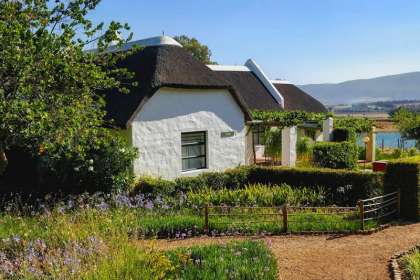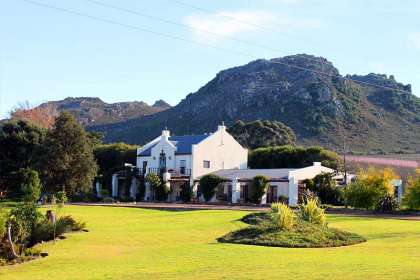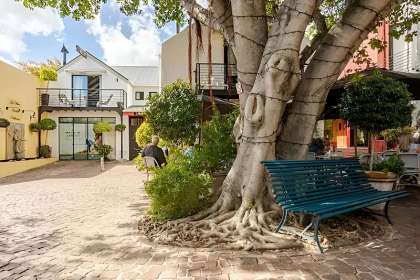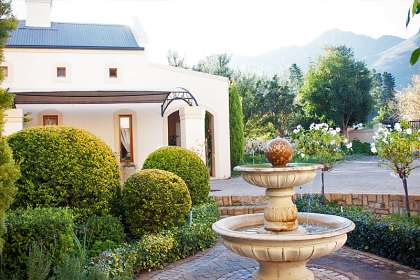Huguenot Tunnel - nr Paarl, Cape Winelands
Huguenot Tunnel - nr Paarl, Cape Winelands
The Huguenot Tunnel, situated near Paarl in the Western Cape, is a vital infrastructure project that significantly enhances transportation in the region. Opened to the public in March 1988, this tunnel stretches approximately 3.9 kilometers through the Du Toitskloof Mountains, providing a direct and efficient route between Paarl and Worcester. The tunnel is named after the Huguenots, French Protestant settlers who arrived in the Cape during the late 17th century and significantly influenced the area's culture and wine industry. By bypassing the winding and often hazardous Du Toitskloof Pass, the Huguenot Tunnel reduces travel time and improves road safety for commuters and freight transporters alike.
The construction of the Huguenot Tunnel was a remarkable engineering feat, involving advanced techniques to navigate the challenging mountainous terrain. The tunnel's design includes a single bore accommodating two lanes of traffic, with a parallel service tunnel for maintenance and emergency use. This design not only ensures the smooth flow of vehicles but also incorporates state-of-the-art safety features. These include ventilation systems to manage air quality, emergency exits, and monitoring systems to ensure the safety and security of all tunnel users. The tunnel's strategic importance is underscored by its role in facilitating the movement of goods and people, thereby supporting the economic vitality of the Western Cape region.
Beyond its functional benefits, the Huguenot Tunnel offers travelers stunning views of the surrounding natural landscape as they approach its entrances. The Du Toitskloof Mountains and the lush vineyards of the Franschhoek Valley provide a picturesque backdrop, making the journey through the tunnel a visually appealing experience. For tourists and locals alike, the tunnel serves as a gateway to the many attractions of the Cape Winelands, including renowned wineries, gourmet restaurants, and historic sites. Its contribution to both the practical aspects of regional connectivity and the enhancement of the travel experience makes the Huguenot Tunnel a noteworthy landmark in the Western Cape.
4 Interesting facts about the Huguenot Tunnel:
1. Length and Construction: The Huguenot Tunnel is approximately 3.9 kilometers long, making it one of the longest road tunnels in Africa. Its construction involved advanced tunneling techniques to navigate through the challenging Du Toitskloof Mountains.
2. Economic Impact: By providing a direct route between Paarl and Worcester, the tunnel significantly reduces travel time and transport costs, thus boosting the economic activity in the Western Cape by facilitating efficient movement of goods and people.
3. Safety Features: The tunnel is equipped with modern safety systems, including ventilation to manage air quality, emergency exits, and continuous monitoring. A parallel service tunnel is also available for maintenance and emergency purposes, ensuring the safety of all users.
4. Engineering Feat: The construction of the Huguenot Tunnel was a significant engineering achievement, requiring precise planning and execution. The project utilised state-of-the-art technology and techniques of the time to overcome the challenges posed by the mountainous terrain.
Accommodation Near Huguenot Tunnel - nr Paarl, Cape Winelands
Mooi Bly
Self Catering House, Cottage, Chalet Accommodation in Paarl
8.7km from Huguenot Tunnel - nr Paarl, Cape WinelandsMooi Bly offers five well-appointed, charming thatched cottages that can sleep up to six people, situated in a big garden with a swimming pool. They are fully equipped, serviced, have private verandas with barbecue facilities and a magnificent view of the …see more for bookings / enquiries and info.
5 Konings Guesthouse
Bed & Breakfast Accommodation in Paarl
13.5km from Huguenot Tunnel - nr Paarl, Cape Winelands5 Konings Guesthouse offers bed and breakfast accommodation in Paarl, in the heart of the Cape Winelands. Stay in one of our 8 stylishly decorated, en-suite rooms catering for your comfort and enjoyment. All the rooms are equipped with air conditioning... …see more for bookings / enquiries and info.
Middelplaas Paarl Guesthouse
Self Catering Apartment, Flatlet Accommodation in Paarl
13.6km from Huguenot Tunnel - nr Paarl, Cape WinelandsMiddelplaas Paarl Guest house is set on a tranquil farm situated within easy reach of the town centre. It is an ideal destination for corporate guests, holidaymakers, wedding guests, school groups, team builders or sports groups. …see more for bookings / enquiries and info.
d'Olyfboom Guesthouse
Bed & Breakfast Accommodation in Paarl
13.9km from Huguenot Tunnel - nr Paarl, Cape Winelandsd'Olyfboom Guesthouse is situated in Paarl and welcomes travellers and tourists who would like to experience the Boland in all its splendour. Each room's porch looks upon the majestic Paarl mountains and beautiful vineyards. …see more for bookings / enquiries and info.
Val d Or Estate
Self Catering Apartment, Flatlet Accommodation in Franschhoek
14.6km from Huguenot Tunnel - nr Paarl, Cape WinelandsVal d'Or Estate offers bed and breakfast and self catering accommodation in Franschhoek in the Cape Winelands and Breede River Valley region in the Western Cape. Nestled in the foothills of the magnificent Franschhoek mountains, a few minutes drive... …see more for bookings / enquiries and info.
Heuwelsig Cottages & Franschhoek Camping
Self Catering House, Cottage, Chalet Accommodation in Franschhoek
14.8km from Huguenot Tunnel - nr Paarl, Cape WinelandsHeuwelsig Cottages & Franschhoek Camping offers both self catering accommodation and special sites specifically for motorhomes in Franschhoek. Heuwelsig Cottages is situated on a working wine farm, surrounded by lush vineyard, orchards and scenic... …see more for bookings / enquiries and info.
Zonnevanger Guest House
Bed & Breakfast Accommodation in Paarl
17.8km from Huguenot Tunnel - nr Paarl, Cape WinelandsTreat yourself to a night in a luxuriously decorated room within a beautiful idyllic garden setting in the Cape Winelands. The guesthouse is surrounded by romantic Lavender Fields and mountains-meet-vineyard-themed outdoor scenery. …see more for bookings / enquiries and info.
Los Olivos
Self Catering Apartment, Flatlet Accommodation in Franschhoek
17.9km from Huguenot Tunnel - nr Paarl, Cape WinelandsLos Olivos luxury self-catering penthouses have one of the best locations in the Franschhoek village. Everything is within walking distance. You can park in our off-street parking and you won’t need your car until the end of your stay. …see more for bookings / enquiries and info.
Petit & Grande Plaisir
Self Catering Apartment, Flatlet Accommodation in Franschhoek
18km from Huguenot Tunnel - nr Paarl, Cape WinelandsPetit & Grande Plaisir Cottages provide self catering accommodation in Franschhoek, in the Cape Winelands and Breede River valley region of the Western Cape. We offer 3 self catering options: Petit Plaisir - Freestanding Self-catering cottage. …see more for bookings / enquiries and info.
22 Van Wijk Street Tourist Accommodation
Room Only / Limited SC Accommodation in Franschhoek
18km from Huguenot Tunnel - nr Paarl, Cape Winelands22 Van Wijk Street Tourism Accommodation provides room only accommodation in Franschhoek in the Cape Winelands and Breede River region in the Western Cape. Four lovely rooms in a pre-1910 house right in the center of Franschhoek. Two Double bed rooms... …see more for bookings / enquiries and info.
- Bainskloof (11.69km)
- Boschenmeer Golf Estate (12.26km)
- Wellington (12.57km)
- Lemoenkloof (13.29km)
- Paarl (13.42km)
- Wemmershoek (15.18km)
- Slanghoek (15.76km)
- Simondium (17.49km)
- Franschhoek (17.83km)
- Windmeul (19.13km)
- Rawsonville (22.25km)
- Breede River (23.09km)
- Klapmuts (24.48km)
- Voor-Paardeberg (24.89km)
- Romansrivier (28.41km)
- Du Toitskloof Pass - Western Cape (0.97km)
- Klein Drakenstein Mountain Range - nr Paarl, Cape Winelands (5.76km)
- Diemersfontein Wine & Country Estate - Wellington, Cape Winelands (11.42km)
- Bobbejaans River Trail & Waterfall - Bain's Kloof Pass (11.56km)
- Paarl Golf Club - Paarl, Cape Winelands (11.66km)
- Bainskloof Pass - Wellington, Western Cape (11.78km)
- Pinotage On Tap - Wellington, Cape Winelands (11.99km)
- Wellington Museum - Wellington, Western Cape (12.75km)
- Akademia, Paarl-kampus - Paarl, Western Cape (12.77km)
- Breytenbach Centre - Wellington, Cape Winelands & Breede Valley (13.11km)
- Paarl Mall - Paarl, Cape Winelands (13.33km)
- Afrikaanse Taalmuseum - Paarl, Cape Town (13.33km)
- Hout Street Gallery - Paarl, Cape Winelands (13.42km)
- Strooidak Kerk (Church) - Paarl, Cape Winelands (13.47km)
- Groot Drakenstein Prison - nr Franschhoek, Cape Winelands (13.62km)
- KWV Brandy Cellar - Paarl, Cape Winelands (13.75km)
- Wellington Wine Harvest Festival - Western Cape (13.92km)
- Wellington Golf Club - Cape Winelands (14.11km)
- Pearl Valley Golf Course - Paarl, Cape Winelands (14.19km)
- Lynx Wines - Franschhoek, Cape Winelands (14.22km)
- Laborie Lazy Days Market - Paarl, Cape Winelands (14.31km)
- Eikehof Wines - Franschhoek, Cape Winelands (15.17km)
- Die Afrikaanse Taalmonument - nr Paarl, Cape Winelands (15.75km)
- Grande Provence Wine Estate - Franschhoek (16.53km)
- Tweede Tol Picnic & Camping Site - Bain's Kloof Pass, Western cape (16.81km)
- Solms-Delta Wine Estate - nr Franschhoek, Cape Winelands (16.91km)
- Franschhoek Oesfees - Cape Winelands (16.92km)
- Franschhoek Wine Tram - Cape Winelands (17.35km)
- Franschhoek Motor Museum - Cape Winelands (17.40km)
- Le Bonheur Reptiles and Adventures - Simondium, Cape Winelands (17.50km)
 The northern entrance to the Huguenot Tunnel on the N1 highway in the Western Cape. ©
The northern entrance to the Huguenot Tunnel on the N1 highway in the Western Cape. © 










